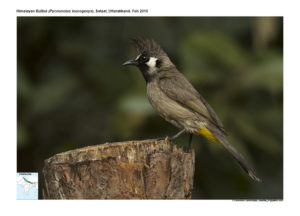
Himalayan Bulbul Pycnonotus leucogenys
Etymology:
- Pycnonotus : Greek word puknos thick, compact; notos –backed { thick backed}
- Leucogenys: Greek word leukos -white; genus -cheek. { White Cheeked}
Vernacular Names: Hindi: Himalayi Bulbul
The alternate name white-cheeked bulbul, or yellow vented bulbul
Distribution in India: Resident of Western Ghats of India
Description: Size of 19–20 cm; wt. of 34–38 g. It is a medium-sized, jaunty, conspicuous bulbul with
prominent forward-pointing crest. It has prominently white cheeks, black crescent at base of white
ear-coverts; upperparts brownish-grey; throat and upper breast are blackish, rest of underparts are
pale greyish, vent and undertail-coverts are yellow; iris is dark brown or hazel, and has black eyering;
bill is blackish; legs is pinkish-grey to slaty black. Both the sexes are similar. The juvenile has paler
brown plumage overall, including crown and throat.
Habitat: It breeds in wooded valleys, also bushy hillsides, often covered with wild raspberry and
hedgerows, groves, parks, gardens and even town centers. It is usually found at 300–2400 m,
sometimes higher where trees are fruiting; descends to level lowlands in winter.
Food Habits: It feeds on insects, figs and the berries of various scrub plant species. It is usually found
in pairs or small parties; occasionally large flocks in non-breeding season. It is boisterous, often
perching atop bushes and constantly flicking wings and tail. It is often very tame, coming to picnic
sites and outdoor cafes to steal crumbs and sugar. It often comes to ground to pick up invertebrates,
snatching them off branches, or catching them in brief aerial sallies.
Breeding Habits: The breeding season is mainly Apr-Aug. The nest is built mainly /entirely by female.
The nest is a shallow, sometimes flimsy, cup-shaped structure of fibers, woody plant stems and
grass, lined with rootlets and fine grass, usually placed low above ground in tree or bush; often in
garden or around building, where regularly tucked into thatched rooftop, or in vines climbing tree or
wall. They lay a clutch of 3–4 eggs. When a clutch is lost, replacement laid shortly after. The
incubation is done mainly or entirely by female, but both parents tend nestlings and fledglings. Both
sexes observed injury-feigning to lead predators from fledglings. Predation by crows high, as many
nests are poorly concealed